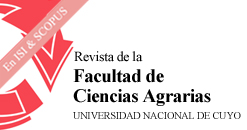Artículo de revista
Huellas hídricas verde y azul del cultivo de maíz (Zea mayz) en provincias del centro y noreste argentino
Green and blue water footprint of corn (Zea mayz) production in central and northeastern provinces of Argentina
Álvarez, Alisa
Instituto Nacional del Agua (Argentina). Centro Regional Andino
-  Enviar un email al autor
Enviar un email al autor
Morábito, José
Instituto Nacional del Agua (Argentina). Centro Regional Andino
-  Enviar un email al autor
Enviar un email al autor
Schilardi, Carlos
Universidad Nacional de Cuyo. Facultad de Ciencias Agrarias
-  Enviar un email al autor
Enviar un email al autor
Publicado en el 2016 en
Revista de la Facultad de Ciencias Agrarias,
Vol. 48, no. 1
Idioma:
Español
Resumen:
Español
La huella hídrica (HH) de un cultivo indica la cantidad de agua evapotranspirada para
obtener una determinada producción, distinguiendo entre el agua procedente de las
precipitaciones (verde) y el agua extraída de ríos, lagos y acuíferos, aplicada mediante
riego (azul). Son objetivos del trabajo estimar las HH verde y azul del maíz en provincias
del centro y del noreste argentino bajo tres condiciones (secano, riego y riego y fertilidad
edáfica óptimos) y analizar el impacto de estas prácticas. Se siguió la metodología
internacionalmente aceptada utilizando el modelo AquaCrop. Los resultados mostraron:
que el riego y la fertilización reducen la HH debido al aumento del rendimiento; que
la huella hídrica verde representa el 92% de la sumatoria (verde más azul) y que la
huella hídrica calculada en secano alcanza un valor medio de 803 L.kg-1 (bajo riego este
valor es de 602 L.kg-1 y con riego y fertilidad edáfica óptimos, de 488 L.kg-1). Esta información
permite al productor valorar convenientemente las prácticas de riego y el uso
eficiente de fertilizantes y concientiza a los administradores del recurso hídrico sobre la
necesidad de diseñar políticas adecuadas para el uso sostenible del agua.
Inglés
The water footprint (WF) of a crop shows the volume of evapotranspired water
required to produce a given yield. The WF splits up into the green WF, which is the
volume of rainwater consumed, and the blue WF, which refers to the volume of surface
and ground water applied through irrigation. The project consists in calculating the
green and blue WF value for corn in central and northeastern provinces of Argentina
under rainfed, irrigated, and optimum irrigation and soil fertility conditions, and in
analyzing the impacts of these practices. Internationally accepted methodology and
the AquaCrop model were used to simulate ETc and crop yield. It was observed that by
applying irrigation and increasing fertility the WF is reduced, this is due to the increase
in yield. The green WF represents 92% of the combined sum (green plus blue). The calculated
mean WF (green plus blue) is 803 L.kg-1 for rainfed farming, 602 L.kg-1 for irrigated
agriculture; and 488 L.kg-1 for production under optimum irrigation and soil fertility
conditions. This information helps producers to adequately assess irrigation practices
and the efficient use of fertilizers, and raises awareness among water administrators of
the need for suitable policies for sustainable water use.
Disciplinas:
Palabras clave:
Descriptores:
Álvarez, Alisa; Morábito, José; Schilardi, Carlos (2016) "Huellas hídricas verde y azul del cultivo de maíz (Zea mayz) en provincias del centro y noreste argentino: ". En: Revista de la Facultad de Ciencias Agrarias, Vol. 48, no. 1, p. 161-177.
Dirección URL del artículo: https://bdigital.uncu.edu.ar/8459.
Fecha de consulta del artículo: 18/05/24.

Este obra está bajo una Licencia Creative Commons Atribución-NoComercial-CompartirIgual 3.0 Unported.
Conozca más sobre esta licencia >



